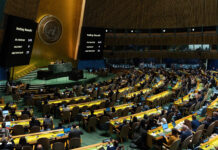The grander a government building is, the more it inflates the egos occupying chairs in those buildings. It is quite ironic that the grandeur of government buildings often seems to be a reflection of the false ego of those in power.
Despite calling for frugality and restraint in public spending against the backdrop of national hyperinflation and global economic recession, many government officials seem to be more interested in building lavish offices and ivory interiors that exude an air of elitism. It is time for the government to set a better example by adopting a minimalist approach to its official expenses and infrastructure.
Instead of basking in the glow of countless tube lights and lamps in their palaces while the masses are choked to death for a bag of flour, the officials should dim down their self-importance. This may cut down government expenses, but, more critically, it will give the people some relief in the knowledge that the government and its officials are trying to do something to address the reality of life in Pakistan. In any case, the lights and lamps of a building do not matter.
It is the ability of the staff to serve the people in a fair and efficient manner that counts. The government needs to prioritise these goals over status symbols.
Just as humans have the ability to turn a mere house into a warm and welcoming home, it is the human touch, the ability to empathise with those seeking justice, and the commitment to serve the people that truly set institutions apart and make them great.
There is a strong ethical and moral imperative for doing so. First, excessive spending on grandiose buildings sends the wrong message to the citizens about the priorities and values of their government.
It creates a perception of wastefulness and extravagance, which undermines public trust in the government’s ability to manage public resources prudently and professionally.
A minimalist approach demonstrates the government’s commitment to responsible use of public funds. Using fewer resources in construction and maintenance can also reduce the carbon footprint of government buildings and help mitigate the effects of climate change.
Finally, by redirecting resources towards essential public services and welfare programmes, the government can address the needs of marginalised communities and promote social justice. This can help bridge the gap between the rich and the poor.
The colonial legacy of building opulent structures should be replaced with a minimalist approach to running the government and its institutions.
It is time to move forward into a world where minimalism and sustainability are the new norms of government infrastructure. At least we can try that.
RAKHSHANDA ABBAS
GILGIT






















